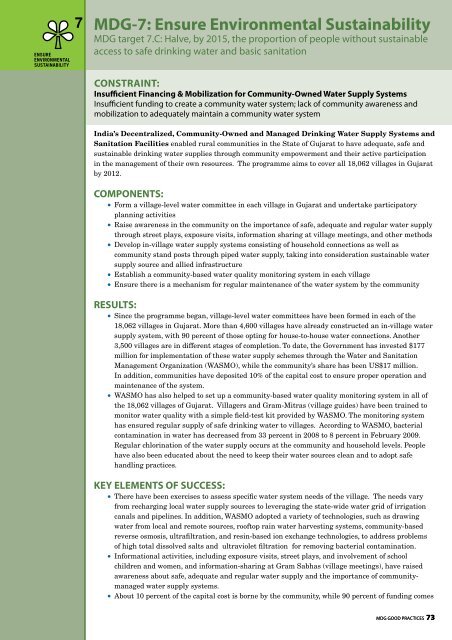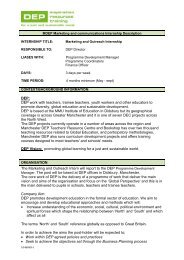Download - United Nations in Cambodia
Download - United Nations in Cambodia
Download - United Nations in Cambodia
- No tags were found...
You also want an ePaper? Increase the reach of your titles
YUMPU automatically turns print PDFs into web optimized ePapers that Google loves.
MDG-7: Ensure Environmental Susta<strong>in</strong>abilityMDG target 7.C: Halve, by 2015, the proportion of people without susta<strong>in</strong>ableaccess to safe dr<strong>in</strong>k<strong>in</strong>g water and basic sanitationConstra<strong>in</strong>t:Insufficient F<strong>in</strong>anc<strong>in</strong>g & Mobilization for Community-Owned Water Supply SystemsInsufficient fund<strong>in</strong>g to create a community water system; lack of community awareness andmobilization to adequately ma<strong>in</strong>ta<strong>in</strong> a community water systemIndia’s Decentralized, Community-Owned and Managed Dr<strong>in</strong>k<strong>in</strong>g Water Supply Systems andSanitation Facilities enabled rural communities <strong>in</strong> the State of Gujarat to have adequate, safe andsusta<strong>in</strong>able dr<strong>in</strong>k<strong>in</strong>g water supplies through community empowerment and their active participation<strong>in</strong> the management of their own resources. The programme aims to cover all 18,062 villages <strong>in</strong> Gujaratby 2012.Components:• Form a village-level water committee <strong>in</strong> each village <strong>in</strong> Gujarat and undertake participatoryplann<strong>in</strong>g activities• Raise awareness <strong>in</strong> the community on the importance of safe, adequate and regular water supplythrough street plays, exposure visits, <strong>in</strong>formation shar<strong>in</strong>g at village meet<strong>in</strong>gs, and other methods• Develop <strong>in</strong>-village water supply systems consist<strong>in</strong>g of household connections as well ascommunity stand posts through piped water supply, tak<strong>in</strong>g <strong>in</strong>to consideration susta<strong>in</strong>able watersupply source and allied <strong>in</strong>frastructure• Establish a community-based water quality monitor<strong>in</strong>g system <strong>in</strong> each village• Ensure there is a mechanism for regular ma<strong>in</strong>tenance of the water system by the communityResults:• S<strong>in</strong>ce the programme began, village-level water committees have been formed <strong>in</strong> each of the18,062 villages <strong>in</strong> Gujarat. More than 4,600 villages have already constructed an <strong>in</strong>-village watersupply system, with 90 percent of those opt<strong>in</strong>g for house-to-house water connections. Another3,500 villages are <strong>in</strong> different stages of completion. To date, the Government has <strong>in</strong>vested $177million for implementation of these water supply schemes through the Water and SanitationManagement Organization (WASMO), while the community’s share has been US$17 million.In addition, communities have deposited 10% of the capital cost to ensure proper operation andma<strong>in</strong>tenance of the system.• WASMO has also helped to set up a community-based water quality monitor<strong>in</strong>g system <strong>in</strong> all ofthe 18,062 villages of Gujarat. Villagers and Gram-Mitras (village guides) have been tra<strong>in</strong>ed tomonitor water quality with a simple field-test kit provided by WASMO. The monitor<strong>in</strong>g systemhas ensured regular supply of safe dr<strong>in</strong>k<strong>in</strong>g water to villages. Accord<strong>in</strong>g to WASMO, bacterialcontam<strong>in</strong>ation <strong>in</strong> water has decreased from 33 percent <strong>in</strong> 2008 to 8 percent <strong>in</strong> February 2009.Regular chlor<strong>in</strong>ation of the water supply occurs at the community and household levels. Peoplehave also been educated about the need to keep their water sources clean and to adopt safehandl<strong>in</strong>g practices.Key Elements of Success:• There have been exercises to assess specific water system needs of the village. The needs varyfrom recharg<strong>in</strong>g local water supply sources to leverag<strong>in</strong>g the state-wide water grid of irrigationcanals and pipel<strong>in</strong>es. In addition, WASMO adopted a variety of technologies, such as draw<strong>in</strong>gwater from local and remote sources, rooftop ra<strong>in</strong> water harvest<strong>in</strong>g systems, community-basedreverse osmosis, ultrafiltration, and res<strong>in</strong>-based ion exchange technologies, to address problemsof high total dissolved salts and ultraviolet filtration for remov<strong>in</strong>g bacterial contam<strong>in</strong>ation.• Informational activities, <strong>in</strong>clud<strong>in</strong>g exposure visits, street plays, and <strong>in</strong>volvement of schoolchildren and women, and <strong>in</strong>formation-shar<strong>in</strong>g at Gram Sabhas (village meet<strong>in</strong>gs), have raisedawareness about safe, adequate and regular water supply and the importance of communitymanagedwater supply systems.• About 10 percent of the capital cost is borne by the community, while 90 percent of fund<strong>in</strong>g comesMDG Good Practices 73








